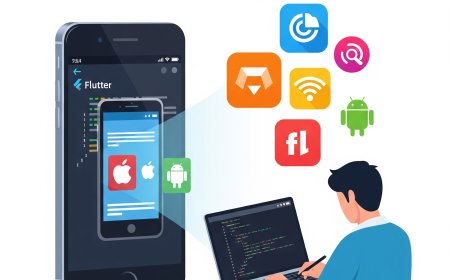The Role of Artificial Intelligence and Machine Learning in Custom Software Development
Explore how AI and ML boost performance, security, and UX in custom software application development for modern businesses.

If youve been in any room where software development is discussed, youve heard it: "AI is the future." Thats no longer just hype. Artificial Intelligence (AI) and Machine Learning (ML) are now the backbone of forward-thinking custom software application development services.
As someone whos seen firsthand how inefficient development cycles, bloated codebases, and generic applications frustrate enterprise users, I can tell you this: AI and ML arent just nice-to-haves anymore. They're necessities for modern, intelligent software that adapts, learns, and scales with your business.
So lets dive into how AI and ML are not just impacting but transforming custom software development and how you canleverage them to create real business value.
AI & ML: Core Drivers of Next-Gen Custom Software
The modern approach to building software has shifted from intuition-led decision-making to insight-driven strategies. Todays development models are fundamentally rooted in data analysis and future-oriented planning, enabling teams to predict trends and preemptively solve issues rather than reacting to them.
Heres whats changed:
-
Data is now king: Apps arent just transactional; theyre insight-generating.
-
Speed and automation are critical: Manual coding is giving way to intelligent code suggestions and automated testing.
-
User expectations have skyrocketed: Predictive personalization is the new standard.
AI and ML technologies inject intelligence at every stage of the software lifecycle, from planning to production.
Smarter Planning: Leveraging AI for Intelligent Requirements Analysis
Defining project requirements has always been a challenging and time-consuming part of software development. Historically, this phase demanded a considerable investment of time and effort engaging with various stakeholders, conducting in-depth market analysis, and compiling detailed documentation by hand to ensure every requirement was captured accurately. While effective, these methods often miss nuanced customer needs andfail to anticipate future demands.
Modern AI tools revolutionize this process by intelligently mining historical project records, analyzing end-user behavior data, and tracking evolving industry trends. These tools can:
-
Identify hidden patterns in user needs based on past project analytics
-
Assess market shifts to recommend forward-compatible features
-
Provide feasibility analysis with predictive cost and timeline estimates
Example: One of our healthcare clients integrated an AI-enabled analytics engine during the discovery phase. By processing existing usage patterns, patient feedback, and performance logs, the tool prioritized features that addressed real-world issues, leading to faster go-to-market and higher patient satisfaction.
By embedding AI at the planning stage, developers and product managers gain a data-backed foundation for every design and feature decision, increasing project success rates.
Adaptive UI/UX: Elevating Design Through Behavioral Insights
Todays digital users demand more than just visually appealing screens they expect experiences that evolve alongside their interactions. Static, one-size-fits-all interfaces simply cant meet those dynamic expectations anymore. Users expect software that understands and adapts to their behavior. Machine Learning introduces dynamic UI/UX personalization based on real-time interactions.
By continuously learning from how users navigate and use the application, ML can:
-
Rearrange menus and options to prioritize frequently used features
-
Personalize dashboard layouts for role-specific experiences
-
Suggest shortcuts or automations based on repeated tasks
Personal Insight: During a redesign of a logistics management platform, we implemented ML algorithms that tracked driver workflows. Within weeks, the UI evolved to highlight most-used routes and tools for each individual, cutting task time by nearly one-third.
ML-driven UI/UX not only enhances user satisfaction but also boosts productivity, ensuring your application becomes more intuitive with every use.
Accelerating Development with AI-Assisted Coding and Refactoring
The focus of modern development teams has moved beyond simply creating code to optimizing speed, accuracy, and maintainability. Instead of building each function manually, developers are now supported by AI-enhanced environments that intelligently assist at every turn.
Artificial Intelligence-powered tools like GitHub Copilot and Tabnine have transformed the coding experience by:
-
Offering intelligent code completions based on project context
-
Suggesting best practices and efficient algorithms
-
Identifying logical errors before compilation
These AI-driven assistants dont just speed up development they enhance code quality. They learn from vast code repositories, continuously improving their recommendations to align with industry standards.
Softura Insight: After introducing intelligent development tools internally, our engineering teams observed a significant 40% drop-in time spent identifying and fixing bugs. This also allowed us to accelerate project timelines and deliver more stable releases to enterprise clients.
By automating the mundane and complex parts of programming, AI allows developers to focus on problem-solving and innovation delivering better outcomes in less time.
Elevating Testing Standards: AI for Quality Assurance and Reliability
The traditional approach to software testing often relied on predefined test cases, manual reviews, and regression tests performed after deployment. This reactive model struggles to keep pace with agile environments where speed and reliability are paramount.
AI has redefined the testing paradigm. Today, intelligent testing frameworks use ML to predict failure points, auto-generate test scripts, and simulate user behavior across multiple environments. This results in:
-
Increased test coverage with fewer human resources
-
Early bug detection before they affect user experience
-
Continuous monitoring for performance issues
Real-World Impact: We implemented an AI-driven regression testing solution for an eCommerce partner, reducing their release cycle from 3 weeks to just 5 days. Even with this acceleration, customer complaints and post-release bugs declined sharply.
Real-Time Intelligence: Empowering Applications with AI Analytics
Modern custom applications must do more than function; they must inform, guide, and adapt. AI analytics brings this capability into the software by turning data into actionable insights.
AI-powered analytics engines offer:
-
Real-time trend monitoring
-
Predictive forecasting
-
Custom dashboard personalization based on user goals
C-Level Insight: Todays business leaders expect apps to function like data-driven advisors. By embedding machine learning models that analyze user input and suggest next steps, applications evolve into strategic tools.
Whether its financial software predicting market risks or healthcare tools offering treatment insights, AI-infused analytics transform passive systems into proactive business enablers.
Continuous Learning Post-Launch: ML-Driven Improvement Loops
In the past, deploying a software solution often meant the end of the project. Today, however, successful applications are designed to evolve continuously, long after launch.
Machine learning equips software with the ability to evolve independently by continuously analyzing user interaction data, adapting features based on real-world usage, and making iterative enhancements without manual intervention. Specifically, ML enables systems to:
-
Monitoring user patterns and interactions dynamically
-
Pinpointing system inefficiencies based on behavioral data
-
Making real-time recommendations for feature adjustments or optimizations
Benefits Include:
-
Less reliance on user-reported issues
-
More relevant updates and upgrades
-
Higher long-term user engagement
With post-deployment ML insights, software becomes more refined, relevant, and valuable with each user interaction.
Enhancing Security Using AI-Powered Detection and Response
Cybersecurity threats are becoming more sophisticated, and static security frameworks are struggling to keep up. AI adds an adaptive, predictive layer to software protection.
Utilizing cutting-edge methodologies like anomaly spotting, behavioral trend monitoring, and advanced pattern recognition, AI-driven systems can:
-
Detect abnormal login behaviors and fraudulent activities as they occur by analyzing access patterns and identifying deviations from established user behavior baselines
-
Flag unusual data transfers or unauthorized access
-
Take swift, autonomous actions against emerging security risks to neutralize them before they develop into larger issues
Case Example: In one of our fintech solutions, we integrated an AI engine that monitored user behavior and flagged transactions outside typical patterns. This early-warning mechanism was able to detect fraudulent activity with more than 95% precision, outperforming traditional security approaches by identifying risks significantly earlier in the transaction cycle.
By integrating security intelligence into your software, you ensure compliance, protect brand integrity, and build user trust.
Barriers and Considerations: Strategic Adoption of AI/ML
Despite the substantial advantages, integrating AI and ML into custom software development introduces several nuanced challenges that require careful planning and strategic execution:
-
Data dependency: High-quality, diverse data sets are crucial for accuracy.
-
Integration complexity: Embedding AI features into legacy systems may require extensive refactoring.
-
Cost and expertise: Building and training models require upfront investment and skilled talent.
-
Ethical concerns: Ensuring fair, unbiased decision-making and protecting user privacy is non-negotiable.
Pro Tip: Always start with a well-defined problem, then assess if AI offers measurable value before proceeding with full integration.
Conclusion: Build Smarter, Not Just Faster
Artificial Intelligence and Machine Learning are no longer experimental add-ons in the development process. They are foundational elements of smart, responsive, and future-proof applications. From streamlining coding and testing to empowering decision-making and security, AI is reshaping the way software is imagined, created, and sustained.
C-Level Takeaway: If youre not integrating AI into your custom software roadmap, youre already behind. The question isnt "should we adopt AI?" Its about identifying the areas in your business where AI can deliver the highest value immediately where it can solve pressing challenges, streamline operations, or unlock new opportunities for growth
Why Softura Is Built for This Future
At Softura, we understand that AI is not just a trendits a tool to deliver exceptional business outcomes. Our teams integrate AI across every phase of software development, ensuring your solution is agile, adaptive, and aligned with strategic goals.
Want to explore what intelligent custom development looks like for your business? Contact us today.






































